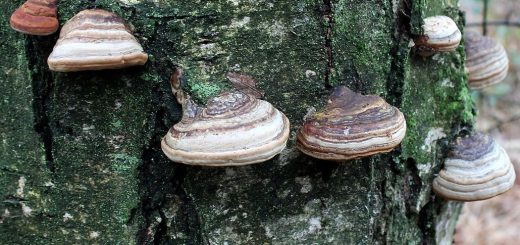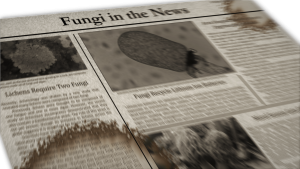#032: Mushroom Morphology: Cup Fungi
The defining features of cup fungi include spores borne in asci, a smooth, upper spore-bearing surface, and a sterile surface underneath. Most cup fungi are saprobic, but it has been recently suggested that some of the large cup fungi may be at least partially mycorrhizal. Although I am discussing cup fungi as a morphological type and these fungi are usually grouped together in identification keys, the term “cup fungi” covers a variety of different shapes. So-called “cup fungi” can be flat to slightly turned up at the edges to bowl-shaped to goblet-shaped to vase-shaped to vase-shaped with a slit down the side to shaped like a bunch of cups squished together (accordion style). Despite these various morphologies, this collection of mushrooms is differentiated into at most three groups: small cup fungi, large cup fungi, and ear fungi. To get a better idea of what I describe below, I would recommend doing a quick image search for the species I mention.
Ear fungi comprise the most morphologically distinct group among these three. Most of these fungi produce mushrooms that resemble livestock ears: vase-shaped with a slit down the side. One of the best examples of an ear shape is Wynnea americana. The other two groups are a hodgepodge of various cup shapes separated based on size at maturity. Small cup fungi (with cups 0.5 cm or less) are found fruiting on decomposing wood, often in large numbers. Although the cups may be small, some species produce rather long stipes (up to 10cm). One of my favorite cup fungi is Chlorociboria aeruginascens, which produces small, green-blue cups on well-decomposed wood. This fungus is unique in that the mycelium turns the wood blue. If you ever see blue wood in the forest, you can be sure C. aeruginascens is around! Another notable small cup fungus is Microstoma floccosum. I highly recommend that you look up this odd-looking mushroom. I’m pretty sure I’ve seen a larger, animate version of M. floccosum on a sci-fi show. Large cup fungi (usually greater than 3cm) are found fruiting on wood or the forest floor. Large cup fungi all lack a stipe but are usually attached to their substrate at the center of the cup by a short knob. One of the easiest mushrooms to find this time of year (the start of morel season—get excited!) is Sarcoscypha austriaca. Its bright red colors make it stand out from the brown forest litter. Another commonly encountered large cup is Peziza domiciliana, which (as you might guess) likes to grow in damp places in houses. For an example of the variety of shapes within the cup fungi, take a look at Urnula craterium, commonly known as the “Devil’s Urn.” There are many other large cups that are brown and impossible to separate from one another without detailed microscopic analysis.
Cup fungi comprise a polyphyletic group, but are all placed within the phylum Ascomycota. Most cup fungi are placed in the class Pezizomycetes and the order Pezizales, along with the morels, false morels, and verpas. Other cup fungi, such as Chlorociboria aeruginascens, are placed in the class Leotiomycetes and the order Helotiales. Because cup fungi are ascomycetes, you can often see them releasing their spores in large puffs when you disturb the air over the cup (by picking it up or blowing on it). See FFF#012 for more on this phenomenon.
See Further:
http://www.mushroomexpert.com/cups.html
Miller and Miller, “North American Mushrooms…”, partially viewable here: http://books.google.com/books?id=zjvXkLpqsEgC&printsec=frontcover#v=onepage&q&f=false

![#005: Xylaria polymorpha, Dead Man’s Fingers [Archived]](https://www.fungusfactfriday.com/wp-content/themes/hueman/assets/front/img/thumb-medium-empty.png)






![#011: Characteristics of Kingdom Fungi [Archived]](https://www.fungusfactfriday.com/wp-content/themes/hueman/assets/front/img/thumb-small-empty.png)


2 Responses
[…] love mycology; more often than not, names make sense!). The Orange Peel Fungus is a cup fungus (see FFF#032) but is a bit more saucer-shaped than cup-shaped; it is roughly circular and usually has upturned […]
[…] G. brunnea belongs to the family Discinaceae, which includes elfin saddles, false morels, and numerous cup fungi. This family is placed in the order Pezizales, which includes most cup fungi as well as morels and verpas. Fungi in this order are known for their ability to produce puffs of spores when you blow on them. You don’t see this very often in the larger mushrooms in the order, but I recently managed to get a video of G. brunnea releasing a puff of spores (see the video above). To learn more about how this works, see my page on cup fungi (FFF#032). […]